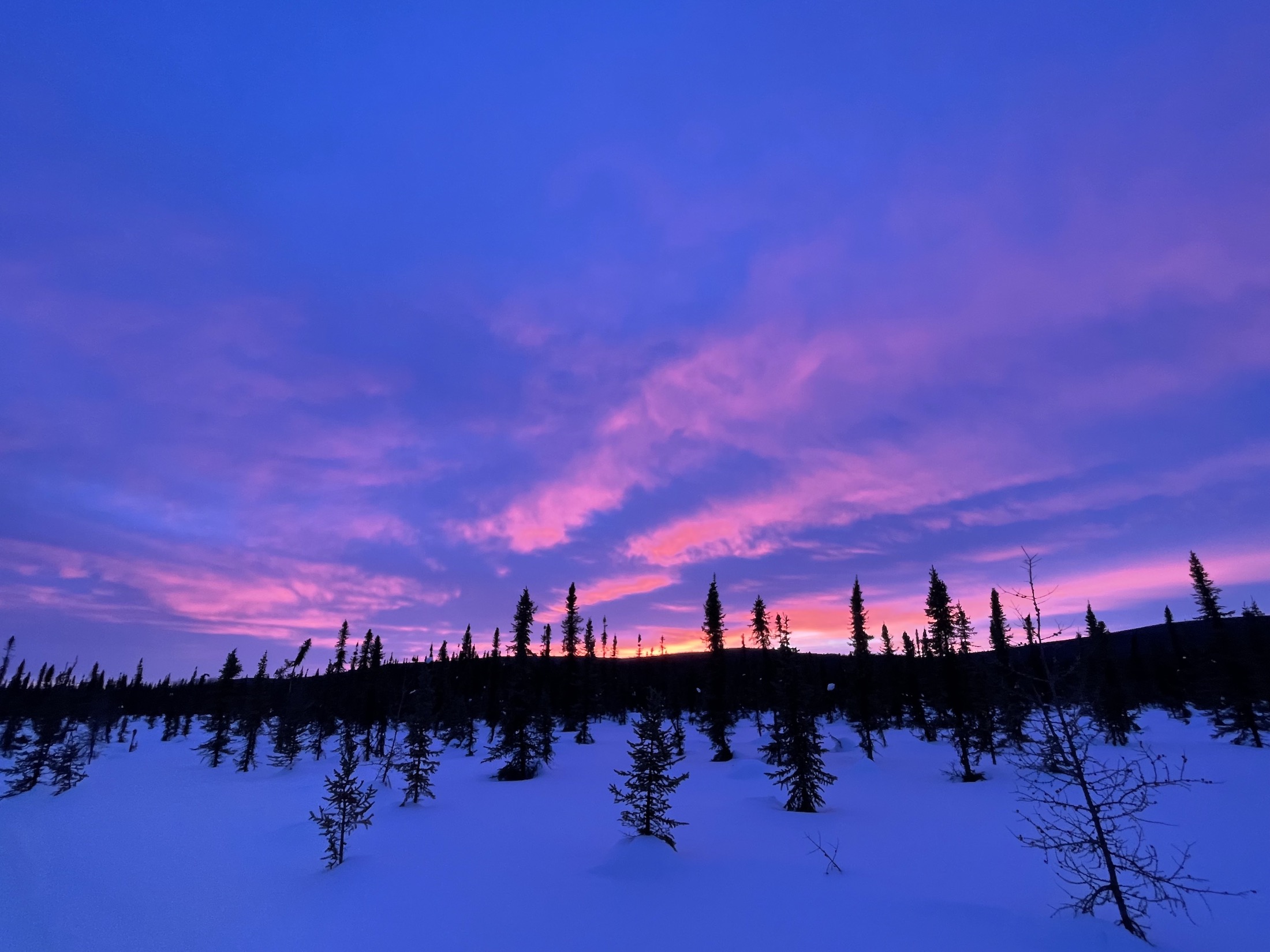Raven roosts shrouded in mystery
Ned Rozell
907-474-7468
March 30, 2023

Sunset falls over an Interior Alaska landscape into which hundreds of ravens flew recently.
Last week, while getting ready to climb into a bunk, I heard the yell of a raven outside. And then another, and a few more. I pulled on my boots.
Outside, a steady stream of black bodies glided overhead, many of them swooping down to check me out. Their wings pushed the air in soft puffs as they continued past, 20 feet above the tops of wiry black spruce trees.
As the sun set and the sky dimmed, the birds kept coming. At first, they looked like bats against the purple of the sky. Then they got closer, larger and chattier, some in groups of fives or sixes.
It was hard to comprehend this river of life above a winter landscape that felt so dead minutes before.
I started counting. Shivering too. I went back inside the cabin when I hit 129 ravens. Inside, I heard more talking as birds continued to pass overhead.
The ravens, coming from the direction of Fairbanks more than 30 miles away, were probably headed to a communal roosting site for the night. In this case, that gathering place might have been the spruce hillside behind the cabin, farther than I could see. I imagined a group of trees decorated with black ornaments.
Scientists in Fairbanks, in Anchorage and outside Alaska have studied raven roosts. They have wondered why the birds gather together at night, sometimes in urban areas and other times in wild ones far from people.
In the 1990s, Bernd Heinrich and John and Colleen Marzluff — all then at the University of Vermont — climbed trees in Maine before sunset to watch ravens roosting in groves of eastern white pine trees. After much watching and a little experimentation, they came up with the theory that the nighttime resting areas were “information centers,” where ravens shared news about recently fallen deer carcasses. They came to that conclusion by capturing ravens and then releasing them near new food sources the scientists had dragged out on the landscape.

A raven scans the horizon. Ravens are one of several animals known to gather together when resting at night.
“The most dramatic case was the bird that returned with roost-mates on the day after discovery,” the scientists wrote in a 1996 paper. “We had released the radio-tagged bird at a pile of meat two hours before sunset. It remained near the food, but did not feed.”
As night fell, that raven then joined a roost in a pine grove a few kilometers away.
“Before dawn the following morning 30 ravens arrived . . ., flying directly from the nearby roost. The radio-tagged bird was among the first five to arrive.”
With that and other observations, the scientists seemed to prove that ravens in the wild share news, but what about ravens that commute every winter day to and from Alaska cities?
Biologist Rod King once tracked Fairbanks ravens to a roost that was a similar distance from Fairbanks to the one I was near recently. He couldn’t say why an animal so adapted to people and our excess food would fly 40 miles from the city every winter evening, only to end up back at Burger King the next morning.
In recent years, people have also seen ravens roosting on manmade structures — such as on the block letters above storefronts in Fairbanks.

Ravens roost for the night on the letters of a grocery store in Fairbanks.
“It’s a great place, with a direct line to the landfill and McDonald’s,” Susan Sharbaugh, a former biologist with the Alaska Bird Observatory, said in 2011 of an urban roost. “If you can knock out a commute to the Goldstream Valley or Chena Hot Springs Road, why not? Energetically it makes all the sense in the world.”
Why then, are hundreds of Fairbanks ravens now commuting to a quiet patch of woods so far from their chief benefactors? It’s one of those things that scientists just don’t know.
“We need to have a few of these mysteries,” King once said.
Since the late 1970s, the Â鶹ąŮÍř Fairbanks Geophysical Institute has provided this column free in cooperation with the UAF research community. Ned Rozell is a science writer for the Geophysical Institute.


